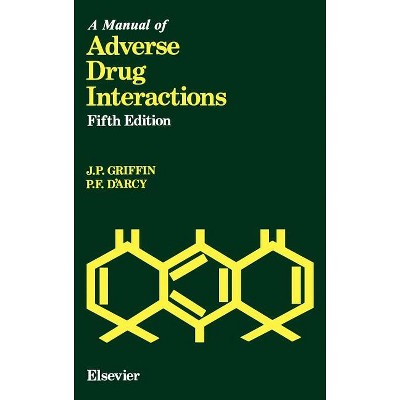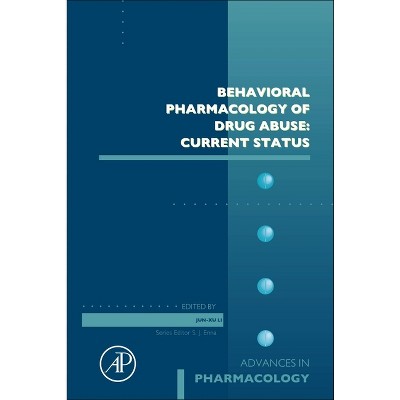Sponsored

Advances in Antiviral Drug Design - by E de Clercq (Hardcover)
$128.99
In Stock
Eligible for registries and wish lists
Sponsored
About this item
Highlights
- The fourth volume of Advances in Antiviral Drug Design is keeping up with the recent progress made in the broad field of antiviral drug research and encompasses six specific directions that have opened new avenues for the treatment of HIV and other virus infections.
- Author(s): E de Clercq
- 230 Pages
- Medical, Pharmacology
- Series Name: Advances in Antiviral Drug Design
Description
Book Synopsis
The fourth volume of Advances in Antiviral Drug Design is keeping up with the recent progress made in the broad field of antiviral drug research and encompasses six specific directions that have opened new avenues for the treatment of HIV and other virus infections. First, as the introductory chapter, the different new anti-HIV agents that are now in preclinical or clinical development are reviewed by E. De Clercq. This includes new NRTIs, NNRTIs and PIs, but also HIV entry/fusion inhibitors as well as integrase inhibitors, and some of these agents, such as the NRTI emtricitabine [(-)FTC] and the PI atazanavir, may soon be licensed for clinical use. Second, high expectations are vested in the potential therapeutic usefulness of inhibitors of HIV integration, a point of no return in the life cycle of HIV, and this approach is highlighted by D.J. Hazuda and S.D. Young. Third, as all currently available PIs can be described as "peptidomimetic", and, therefore, expected to demonstrate overlapping virus-drug resistance and side effect profiles, it would be interesting to see how a non-peptidic protease inhibitor such as tipranavir behaves, and this is covered by D. Mayers, K. Curry, V. Kohlbrenner and S. McCallister. Fourth, neuraminidase inhibitors such as zanamivir (that has to be inhaled) and oseltamivir (that can be administered via the oral route) have gained a definitive status as antiviral drugs useful for both therapy and prophylaxis of influenza A and B virus infections; as they target a specific influenza viral enzyme, neuraminidase (or sialidase), they may be expected to block newly emerging influenza viruses as well, and the design of neuraminidase inhibitors has received due attention of H. Jin and C.U. Kim. Fifth, while the major current efforts in antiviral drug development have shifted from herpesviruses towards HIV and hepatitis viruses [hepatitis B virus (HBV), hepatitis C virus (HCV)], it is interesting to note that by switching from the classical five-membered sugar or acyclic nucleoside strategy, J. Wang, M. Froeyen and P. Herdewijn have gone "upstream" in designing six-membered carbocyclic nucleosides as potential anti-herpesvirus agents. Sixth, following up on the nucleotide prodrug strategy introduced above under ix, to deliver the biologically active nucleotides inside the cells, C. Meier has elaborated on a particular class of such pronucleotides, namely that of the cyclosaligenyl pronucleotides, an approach that should have far reaching implications for compounds effective against HIV, HBV and other viruses. The six topics covered in this fourth volume of Advances in Antiviral Drug Design are in the front line of the present endeavors towards the design and development of new therapeutic agents for virus infections. They pertain to the combat against three of the most important viral pathogens of current times: HIV, HBV, influenza virus and herpesviruses.Review Quotes
"All six chapters in the current volume are up-to-date, interesting reading, and written by experts on each subject...The first chapter on "New Anti-HIV Agents in Preclinical or Clinical Development" is written by the editor, who is a recognized authority in this area. It is an excellent overview of current advances in the clinic and laboratory. Not only does this review thoroughly cover drugs acting by conventional mechamisms, such as reverse transcriptase and protease inhibition, it also details agents operating by novel mechanisms...A highlight of the volume is the chapter by Gilead co-workes Jin and Kim entitled "Design of Neuraminidase Inhibitors as Anti-Influenza Virus Agents". This is an excellent description of the medical chemistry of an important new class of antiviral drugs based on enzyme X-ray structures and structure-activity relationships...it provides very useful information and it is thorough in some areas...it should be an essential acquisition for complete libraries in academic institutions and pharmaceutical companies." --Thomas W. Bell, University of Nevada, Reno for JOURNAL OF THE AMERICAN CHEMICAL SOCIETY, Vol. 126, 2004
Dimensions (Overall): 9.17 Inches (H) x 6.37 Inches (W) x .58 Inches (D)
Weight: 1.1 Pounds
Suggested Age: 22 Years and Up
Number of Pages: 230
Genre: Medical
Sub-Genre: Pharmacology
Series Title: Advances in Antiviral Drug Design
Publisher: Elsevier Science
Format: Hardcover
Author: E de Clercq
Language: English
Street Date: December 1, 2003
TCIN: 1005873854
UPC: 9780444506023
Item Number (DPCI): 247-15-3871
Origin: Made in the USA or Imported
If the item details aren’t accurate or complete, we want to know about it.
Shipping details
Estimated ship dimensions: 0.58 inches length x 6.37 inches width x 9.17 inches height
Estimated ship weight: 1.1 pounds
We regret that this item cannot be shipped to PO Boxes.
This item cannot be shipped to the following locations: American Samoa (see also separate entry under AS), Guam (see also separate entry under GU), Northern Mariana Islands, Puerto Rico (see also separate entry under PR), United States Minor Outlying Islands, Virgin Islands, U.S., APO/FPO
Return details
This item can be returned to any Target store or Target.com.
This item must be returned within 90 days of the date it was purchased in store, shipped, delivered by a Shipt shopper, or made ready for pickup.
See the return policy for complete information.
Trending Non-Fiction

$19.31
was $20.98 New lower price
4 out of 5 stars with 64 ratings

$4.59
MSRP $7.99
Save $5 when you spend $20 on select books
4.8 out of 5 stars with 123 ratings

$6.20
MSRP $10.95
Save $5 when you spend $20 on select books
4.8 out of 5 stars with 33 ratings

$7.09
MSRP $9.99
Save $5 when you spend $20 on select books
4.9 out of 5 stars with 46 ratings














